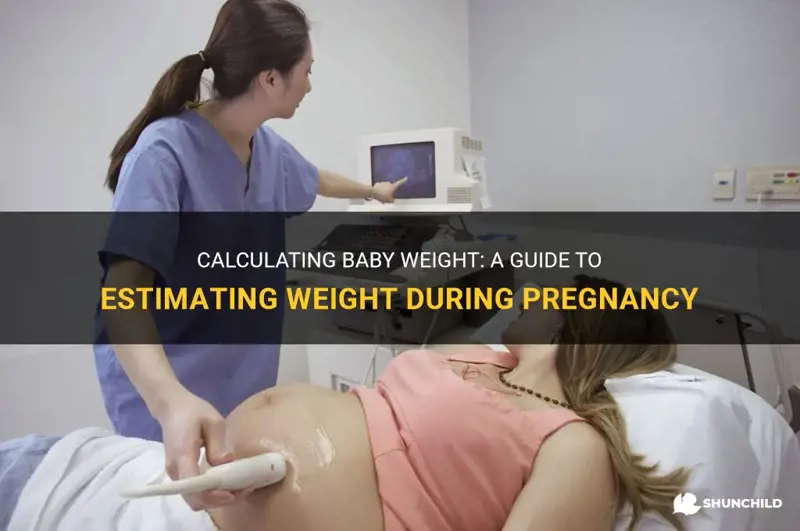
When it comes to pregnancy, one of the most common questions expectant mothers have is how much their baby weighs. While it may seem like a simple question, calculating baby weight during pregnancy is actually a complex process that takes into account numerous factors. From the mother's weight gain to the baby's development, there are various methods that healthcare professionals use to estimate baby weight. In this article, we will explore the different ways baby weight is calculated during pregnancy, shedding light on this captivating aspect of the journey to motherhood.
| Characteristic | Value |
|---|---|
| Method of calculating baby weight | Ultrasound measurements |
| Gestational age used for calculating baby weight | Estimated gestational age |
| Factors considered for calculating baby weight | Baby's size, growth, and position in the womb |
| Accuracy of baby weight calculation | +/- 10% |
| Timing of baby weight calculation | Usually done during the third trimester of pregnancy |
| Purpose of calculating baby weight | To monitor baby's growth and development |
| Units used for reporting baby weight | Grams or pounds |
| Equipment used for measuring baby weight | Ultrasound machine |
| Health care professional responsible for calculating baby weight | Obstetrician, midwife, or ultrasound technician |
| Average baby weight at full term | 2.7 to 4.1 kilograms (6 to 9 pounds) |
What You'll Learn
- What factors are considered when calculating a baby's weight during pregnancy?
- How accurate are prenatal weight calculations in determining the baby's actual weight at birth?
- Is there a standard method or formula used to calculate baby weight during pregnancy?
- Are there any potential health risks associated with having a baby with a high or low estimated weight during pregnancy?
- Can ultrasound measurements accurately predict the baby's weight before birth?

What factors are considered when calculating a baby's weight during pregnancy?
Calculating a baby's weight during pregnancy is an essential part of monitoring the growth and development of the fetus. Several factors are taken into consideration when determining the weight of a baby, providing valuable information about the health and well-being of both the mother and the baby.
- Gestational age: The most crucial factor in calculating a baby's weight is the gestational age. Gestational age refers to the number of weeks since the mother's last menstrual period and is typically determined through ultrasound examination. As the pregnancy progresses, the baby's weight increases, so knowing the gestational age helps estimate the weight accurately.
- Mother's weight: The mother's pre-pregnancy weight influences the baby's weight during pregnancy. Women who are underweight tend to have smaller babies, while those who are overweight might have larger babies. Maternal weight gain during pregnancy is also taken into account, as excessive or inadequate weight gain can affect the baby's weight. Regular prenatal checkups allow healthcare providers to monitor and manage the mother's weight gain appropriately.
- Ethnicity and genetics: Ethnicity and genetics play a role in determining the baby's weight. Certain ethnic groups tend to have smaller or larger babies on average. Additionally, the parents' genetic makeup can influence the baby's size. For example, taller parents may have larger babies due to genetic factors.
- Medical conditions: Certain medical conditions, such as gestational diabetes or preeclampsia, can affect the baby's weight during pregnancy. Gestational diabetes, a type of diabetes that develops during pregnancy, can lead to excessive fetal growth, resulting in a larger baby. Conversely, preeclampsia, a condition characterized by high blood pressure and organ damage, may cause growth restriction in the baby.
- Ultrasound measurements: Ultrasound examinations provide valuable information about the baby's weight. During an ultrasound, various measurements are taken, including the circumference of the baby's head, abdomen, and thigh bone length. These measurements are compared to growth charts, allowing healthcare providers to estimate the baby's weight.
- Fundal height measurement: Fundal height measurement involves measuring the size of the mother's abdomen to estimate the baby's weight. This method is commonly used during prenatal checkups. The healthcare provider measures the distance from the pubic bone to the top of the uterus (fundus) using a tape measure. The measurement is then compared to standardized growth charts to estimate the baby's weight.
It is important to note that calculating a baby's weight during pregnancy is not an exact science and only provides an estimation. The actual weight of the baby can only be determined after birth. However, these estimations are helpful for monitoring the baby's growth and development and ensuring appropriate prenatal care. Healthcare providers use the information obtained from these calculations to identify any potential concerns and make informed decisions regarding the mother's and baby's care.
In conclusion, various factors are considered when calculating a baby's weight during pregnancy. These factors include gestational age, the mother's weight and weight gain, ethnicity and genetics, medical conditions, ultrasound measurements, and fundal height measurements. Together, these factors allow healthcare providers to estimate the baby's weight and monitor the overall health and well-being of both the mother and the baby.
Natural Ways to Enhance Baby's Skin Colour During Pregnancy
You may want to see also

How accurate are prenatal weight calculations in determining the baby's actual weight at birth?
Prenatal weight calculations are commonly used to estimate the baby's weight at birth. This estimation is important as it provides valuable information for healthcare providers to plan for a safe delivery and predict any potential complications. However, it is crucial to understand the accuracy of these calculations and the factors that may influence the predictions.
Scientifically, prenatal weight calculations are based on various methods and formulas. One commonly used method is the ultrasound estimation, which calculates the baby's weight by measuring specific fetal biometric parameters, such as the head circumference, abdominal circumference, and femur length. These measurements are then plugged into a formula, usually derived from numerous studies and statistical analyses, to estimate the baby's weight.
Studies have shown that ultrasound estimations can provide a reasonably reliable approximation of the baby's weight. However, it is important to note that these calculations have a margin of error. The accuracy of ultrasound weight estimations decreases as the pregnancy progresses, as factors such as amniotic fluid levels, fetal position, and maternal obesity can affect the measurements.
Another method used to estimate the baby's weight is the measurement of the fundal height. This method involves measuring the distance from the top of the uterus to the pubic bone. The fundal height is correlated with the baby's weight, but it is not as accurate as ultrasound estimations. It can provide a rough estimation but does not account for factors such as the baby's proportion and build.
Experience has also shown that prenatal weight calculations can sometimes be inaccurate. Healthcare providers may encounter cases where the baby's actual weight at birth differs significantly from the estimation. In some cases, the ultrasound may overestimate the baby's weight, leading to unnecessary concerns about potential complications. Conversely, the ultrasound may underestimate the baby's weight, which can also lead to unexpected difficult deliveries.
While prenatal weight calculations can be useful in providing a general idea of the baby's weight at birth, it is important to remember that they are not definitive. The actual weight can be influenced by various factors, including genetics, the mother's health and nutrition during pregnancy, and even the timing of the delivery. It is essential for healthcare providers to consider these factors and use the weight estimations as a guide rather than an absolute measure.
In conclusion, prenatal weight calculations through methods such as ultrasound estimations and fundal height measurements can provide valuable information about the baby's weight at birth. However, it is crucial to understand that these calculations have a margin of error and may not accurately predict the baby's actual weight. Healthcare providers should use these estimations as a guide and consider other factors that can influence the baby's weight to ensure a safe delivery.
The Importance of Regular Prenatal Check-Ups: What to Expect During Your Pregnancy Journey
You may want to see also

Is there a standard method or formula used to calculate baby weight during pregnancy?
During pregnancy, many expectant mothers may wonder about the weight of their baby. It is natural to be curious and want to know how much the little one will weigh when they finally arrive. While there is no exact formula to precisely calculate the baby's weight during pregnancy, there are several methods that can provide an estimate. In this article, we will explore these methods and shed light on what factors can influence the weight of a baby.
One of the most common methods used to estimate baby weight is through ultrasound measurements. Ultrasound is a non-invasive procedure that uses sound waves to create images of the baby's development inside the womb. During an ultrasound, the technician will measure the baby's head circumference, abdominal circumference, and femur length. These measurements can be used to estimate the baby's weight using specialized formulas or growth charts. However, it is essential to note that these estimates can have a margin of error and may not always accurately predict the actual birth weight.
Another method to estimate baby weight is through fundal height measurements. Fundal height refers to the distance between the top of the uterus and the pubic bone. As the baby grows, the uterus expands, and the fundal height increases accordingly. Healthcare professionals often measure the fundal height during prenatal visits using a measuring tape. The measurement is generally taken from around the 20th week of pregnancy onwards. While the fundal height provides a rough estimate of the baby's size, it is important to remember that factors like the mother's body type and the position of the baby can influence the accuracy of this method.
In addition to ultrasound measurements and fundal height, the mother's weight gain during pregnancy can also offer insight into the baby's weight. The American College of Obstetricians and Gynecologists (ACOG) provides guidelines on recommended weight gain based on the mother's pre-pregnancy body mass index (BMI). It is generally expected that a healthy weight gain during pregnancy ranges from 25 to 35 pounds for women with a normal BMI. Research studies have shown a correlation between excessive weight gain during pregnancy and larger birth weight babies. However, it is important to consult with a healthcare provider to ensure that weight gain is within a healthy range.
It is worth noting that genetics also play a significant role in determining the baby's weight. Parents' genetic traits, including their height and build, can influence the baby's growth patterns. If both parents are tall and have a larger build, it is more likely that the baby will have a higher birth weight. Similarly, if both parents are petite, the baby's birth weight may tend to be on the lower side. However, these are general trends, and individual variation is always possible.
In conclusion, while there is no standard method or formula to precisely calculate the baby's weight during pregnancy, estimates can be made using ultrasound measurements, fundal height, and the mother's weight gain. However, it is important to remember that these estimates have a margin of error and may not always accurately predict the actual birth weight. Factors like genetics, the mother's body type, and the baby's position can influence the baby's weight. Ultimately, the most reliable way to determine the baby's weight is through weighing them shortly after birth.
What You Need to Know About the Health of Babies from Cryptic Pregnancies
You may want to see also

Are there any potential health risks associated with having a baby with a high or low estimated weight during pregnancy?
During pregnancy, one of the key factors that doctors monitor is the estimated weight of the baby. The baby's weight can be an indicator of the overall health and development of the fetus, and it is important for expectant mothers to understand the potential health risks associated with having a baby with a high or low estimated weight.
Having a baby with a high estimated weight, also known as macrosomia, can increase the risk of complications during pregnancy and delivery. Macrosomia is commonly defined as a baby weighing more than 8 pounds, 13 ounces. Some of the potential health risks associated with a high estimated weight include:
- Difficult labor and delivery: Babies with a high estimated weight are more likely to require a cesarean delivery due to their size. The size of the baby can make it difficult for the baby to pass through the birth canal, increasing the risk of complications such as shoulder dystocia (when the baby's shoulders get stuck during delivery).
- Increased risk of maternal injuries: The size and weight of the baby can put extra strain on the mother's body during delivery, increasing the risk of tears and injuries to the birth canal, pelvic floor muscles, and other tissues. This may lead to prolonged healing time and increased discomfort postpartum.
- Increased risk of fetal injuries: The force exerted during delivery to deliver a larger baby can increase the risk of birth injuries, such as fractures, nerve damage, and brachial plexus injuries (stretching or tearing of the nerves that control movement and sensation in the arms and hands).
On the other hand, having a baby with a low estimated weight, also known as intrauterine growth restriction (IUGR), can also pose potential health risks. IUGR is characterized by a baby whose estimated weight is below the 10th percentile for their gestational age. Some of the potential health risks associated with a low estimated weight include:
- Poor fetal growth and development: Babies with a low estimated weight may not receive adequate nutrition and oxygen in the womb, leading to slower growth and development. This can affect various organs and systems in the baby's body, increasing the risk of long-term health issues.
- Increased risk of preterm delivery: In some cases, the baby may need to be delivered prematurely if their growth is severely restricted. Preterm babies often require intensive neonatal care and may face long-term complications and developmental delays.
- Increased risk of stillbirth: In severe cases of IUGR, where the baby's growth is severely restricted, there is a higher risk of stillbirth. This is why doctors closely monitor fetal weight and take appropriate measures to ensure the wellbeing of both the mother and baby.
It is important to note that while a high or low estimated weight may present potential health risks, not all babies with these conditions will experience complications. Healthcare providers closely monitor these pregnancies and take necessary precautions to manage any potential risks.
In conclusion, having a baby with a high or low estimated weight during pregnancy can pose potential health risks. It is essential for expectant mothers to receive regular prenatal care and follow the advice of their healthcare provider to manage and mitigate these risks. By closely monitoring the baby's growth and development, doctors can take appropriate measures to ensure a healthy pregnancy and delivery.
Unraveling the Connection: Exploring Why Dreams of Babies and Pregnancy Persist
You may want to see also

Can ultrasound measurements accurately predict the baby's weight before birth?
Ultrasound is a commonly used tool in prenatal care to monitor the development and health of the fetus. One question that often arises is whether ultrasound measurements can accurately predict the baby's weight before birth. In this article, we will explore the scientific evidence, expert opinions, and examples to determine if ultrasound can accurately estimate the weight of a baby.
Ultrasound technology allows healthcare providers to assess various aspects of the fetus, including size and weight. The process involves using sound waves to create images of the baby and measuring specific dimensions to estimate its weight. Several studies have been conducted to investigate the accuracy of ultrasound measurements in predicting fetal weight.
According to a review published in the Journal of Ultrasound in Medicine, ultrasound measurements for estimating fetal weight can be reasonably accurate. However, their accuracy may vary depending on gestational age, maternal factors, and the formula used for calculation. The review suggests that ultrasounds performed closer to birth tend to be more accurate in predicting the baby's weight.
Experts also emphasize that ultrasound measurements should be interpreted alongside other factors, such as maternal weight gain and fundal height. These additional assessments help provide a more comprehensive understanding of the baby's growth and potential weight.
Let's consider an example to illustrate the accuracy of ultrasound measurements in predicting fetal weight. Suppose a pregnant woman undergoes an ultrasound at 36 weeks gestation, and the measurements indicate an estimated weight of 7 pounds. If the woman goes into labor at 38 weeks and delivers a baby weighing 8 pounds, it can be concluded that the ultrasound prediction was reasonably accurate.
However, it is important to note that ultrasound measurements can have limitations. Factors such as maternal obesity or fetal position can affect the accuracy of the estimation. Additionally, the measurements may not account for factors that influence weight gain, such as genetics or fetal nutrition.
In conclusion, ultrasound measurements can provide a useful estimation of the baby's weight before birth. While they can be reasonably accurate, their precision may vary. It is important for healthcare providers to consider other factors and assessments in conjunction with ultrasound measurements to get a more accurate understanding of the baby's weight. Ultimately, the prediction of a baby's weight should be taken as an estimation rather than an absolute certainty.
References:
- American Institute of Ultrasound in Medicine. (2009). Practice guidelines for performance of the routine mid-trimester fetal ultrasound scan. Journal of Ultrasound in Medicine, 28(12), 157–166.
- Cervantes, A., Rodriguez, P., Murillo, C., Acosta, J. A., & Elorza, M. E. (2015). A systematic review on fetal ultrasound biometry nomograms. Journal of Ultrasound in Medicine, 34(6), 981–987.
All You Need to Know About a Pre-Pregnancy Check-Up
You may want to see also
Frequently asked questions
Baby weight is typically calculated through an ultrasound scan. The sonographer measures different parts of the baby's body, such as the head, abdomen, and femur length, to estimate the baby's weight. This measurement is then compared to growth charts to determine if the baby's weight is within the expected range for their gestational age.
Yes, estimated baby weight can sometimes be inaccurate. While ultrasound scans are a common and reliable method for estimating baby weight, there can be a margin of error. Factors such as the baby's position, the skill of the sonographer, and the accuracy of the measurements taken can all contribute to potential inaccuracies in the estimated weight.
The estimated baby weight can help healthcare providers monitor the baby's growth and development throughout the course of the pregnancy. If the estimated weight is significantly outside the expected range, it may indicate a potential issue that needs further investigation. For example, a baby that is measuring larger than expected may suggest gestational diabetes, while a baby measuring smaller than expected may indicate poor growth or other complications.
In some cases, the estimated baby weight can impact the birth plan. If a baby is measuring significantly larger than average, for example, the healthcare provider may recommend a scheduled cesarean section to reduce the risk of complications during vaginal delivery. However, it's important to note that estimated baby weight alone is not the only factor considered in determining the most appropriate birth plan. Healthcare providers also take into account other factors, such as the mother's overall health and any additional risk factors.







